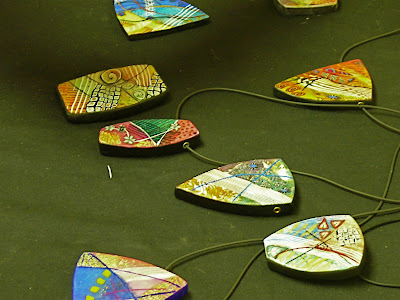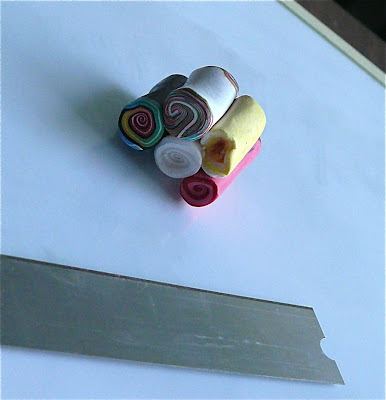
On the first day of 2009 I thought I'd post a tutorial on making a tornado bead. This is a non-polymer posting but I needed these to go with some polymer beads I made recently.
I have been unable to find a tornado bead tutorial online so I figured this one out myself. Hopefully if you are looking for the same thing I was, this will serve as a starting point to making your own tornado beads.
For a one inch bead, you will need:
18" of 20-gauge wire
16" of 22 gauge wire
Various sized seed beads- 11, 8, 6.
A couple of 4mm beads
A mandrel

Beginning in the middle of the 20 gauge wire, wrap wire around a mandrel (I used a small wooden skewer) in both directions until the wrap is one inch long and there is 5"-6" of excess wire on each end. The wraps don't have to be perfectly lined up against each other.

Take the right end of the excess wire and working right to left, wrap it loosely around the base in a somewhat random and disorganized fashion. This isn't about perfection, it's about a tornado!

Take the left end of the excess wire and wrap it around the base from left to right, again in a loose fashion and make the bead slightly fatter in the middle.

Now you are ready to add beads with the 22 gauge wire.

Take 16" of the 22 gauge wire and start a wrap at one end, tucking the end under so it doesn't stick out. Add a few size 11 seed beads in the first revolution.

Start wrapping and adding larger beads to the 22 gauge wire in the gaps between the 20 gauge wire. They will stick out a little at first but become integrated when you continue with the 22 gauge wire.

Continue to wrap and add beads into the gaps, alternating sizes and colors. Take an occasional wire wrap without any beads.

When you reach the other end of the tornado bead, you should have the 22 gauge wire used up. Tuck the end into the bead to conceal the wire end.

Here is the finished bead!







































































